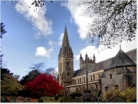





© Llandaff Society
Llandaff -




The Story of Llandaff

Llandaff is located about two miles north-
The Cathedral is sited below the rest of the village on a narrow shelf between the base of the hill and the River Taff. This position was probably chosen because it was near the old river crossing and was also partly hidden from intruders. The site would also have been well served by a line of wells and natural springs along the scarp of the hill.
Immediately east of the Cathedral, the character of the landscape changes to flat, low-
When, however, the first Christian missionaries arrived at what is now Llandaff, the course of the river was probably much further west and very near to the site of the original church. Indeed, the very name Llandaff (meaning ‘church’ or ‘sacred enclosure’ by the Taff) implies that this was the case. Early maps show the River Taff running close to the Cathedral more or less in the position of the mill-
1